Papers by Eirini Rigopoulou
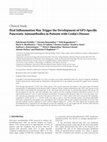
Clinical & Developmental Immunology, 2012
Why zymogen glycoprotein 2 (GP2), the Crohn's disease (CD)-specific pancreatic autoantigen, is th... more Why zymogen glycoprotein 2 (GP2), the Crohn's disease (CD)-specific pancreatic autoantigen, is the major target of humoral autoimmunity in inflammatory bowel diseases (IBD) is uknown. Recent evidence demonstrates that GP2 is also present on the apical surface of microfold (M) intestinal cells. As the colon lacks GP2-rich M cells, we assumed that patients with colonic CD are seronegative for anti-GP2. Anti-GP2 antibodies were tested in 225 CDs, including 45 patients with colonic location (L2), 45 with terminal ileum (L1) and 135 with ileocolonic involvement; 225 patients with ulcerative colitis (UC) were also tested. Anti-GP2 reactivity was detected in 59 (26.2%) CDs and 15 (6.7%) UCs (P < 0.001). Only 5 CDs with L2 had anti-GP2 antibodies, compared to 54/180 (30.0%, P = 0.0128) of the CDs with L1 and L3. Anti-GP2 antibody positive CD patients had higher ASCA titres compared to seronegative cases. Amongst the 128 CD patients with previous surgical intervention, 45 (35.0%) were anti-GP2 antibody positive compared to 14/97 (14.0%) without surgical (P < 0.001). Our data support the assumption that ileal inflammation is required for the development of anti-GP2 antibodies in CD, and suggest that the intestine rather than the pancreatic juice is the antigenic source required for the initiation of anti-GP2 antibodies.
Journal of Gastroenterology and Hepatology, Mar 1, 2007
... Development of antimitochondrial antibodies in patients with autoimmune hepatitis: Art of fac... more ... Development of antimitochondrial antibodies in patients with autoimmune hepatitis: Art of facts or an artifact? Christos Liaskos 1,2 ,; Dimitrios-Petrou Bogdanos 3 ,; Eirini I Rigopoulou 1 ,; George N Dalekos 1. Article first published online: 8 FEB 2007. ...
World Journal of Gastroenterology, Jan 14, 2020
BACKGROUND Non-invasive criteria are needed for Crohn's disease (CD) diagnosis, with several biom... more BACKGROUND Non-invasive criteria are needed for Crohn's disease (CD) diagnosis, with several biomarkers being tested. Results of individual diagnostic test accuracy studies assessing the diagnostic value of pancreatic autoantibodies-to-glycoprotein-2 (anti-GP2) tests for the diagnosis of CD appear promising.
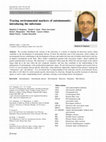
Immunologic Research, Apr 17, 2013
We recently introduced the concept of the infectome as a means of studying all infectious factors... more We recently introduced the concept of the infectome as a means of studying all infectious factors which contribute to the development of autoimmune disease. It forms the infectious part of the exposome, which collates all environmental factors contributing to the development of disease and studies the sum total of burden which leads to the loss of adaptive mechanisms in the body. These studies complement genome-wide association studies, which establish the genetic predisposition to disease. The infectome is a component which spans the whole life and may begin at the earliest stages right up to the time when the first symptoms manifest, and may thus contribute to the understanding of the pathogenesis of autoimmunity at the prodromal/asymptomatic stages. We provide practical examples and research tools as to how we can investigate disease-specific infectomes, using laboratory approaches employed from projects studying the ''immunome'' and ''microbiome''. It is envisioned that an understanding of the infectome and the environmental factors that affect it will allow for earlier patient-specific intervention by clinicians, through the possible treatment of infectious agents as well as other compounding factors, and hence slowing or preventing disease development.

Clinica Chimica Acta, May 1, 2007
Primary biliary cirrhosis (PBC)-specific anti-mitochondrial antibodies (AMA), routinely detected ... more Primary biliary cirrhosis (PBC)-specific anti-mitochondrial antibodies (AMA), routinely detected by indirect immunofluoresnce, immunofix various mitochondrial antigens by immunoblot (IB). We have investigated whether there is a relationship between IFL-determined AMA titres and the number, intensity or pattern of IB-bands. By computer-assisted imaging technology, an IB analysis using human liver mitochondrial preparation was performed in 100 AMA positive PBC samples, subdivided in 5 groups each consisting of 20 cases with very high, high, intermediate, low or borderline IFL titres and in 19 AMA-negative cases. Reactivity to at least 1 mitochondrial band (range 1-12) was present in 114 (96%) cases. Reactivity to the major pyruvate dehydrogenase E2-subunit 74-kDa autoantigen positively correlated with AMA IFL titres but was absent in 25% IFL-positive cases. The intensity and number of IB-bands differed significantly among groups (p&amp;amp;amp;amp;amp;amp;amp;amp;amp;amp;amp;amp;amp;amp;amp;amp;amp;amp;amp;amp;amp;amp;amp;amp;amp;amp;amp;amp;amp;amp;amp;amp;amp;amp;amp;amp;amp;amp;lt;0.001). IFL AMA titres positively correlated with the total number (r=0.8, p&amp;amp;amp;amp;amp;amp;amp;amp;amp;amp;amp;amp;amp;amp;amp;amp;amp;amp;amp;amp;amp;amp;amp;amp;amp;amp;amp;amp;amp;amp;amp;amp;amp;amp;amp;amp;amp;amp;lt;0.001) and the intensity of the IB-bands (r=0.75, p&amp;amp;amp;amp;amp;amp;amp;amp;amp;amp;amp;amp;amp;amp;amp;amp;amp;amp;amp;amp;amp;amp;amp;amp;amp;amp;amp;amp;amp;amp;amp;amp;amp;amp;amp;amp;amp;amp;lt;0.001). Our study indicates that IFL-determined AMA relate to the number and intensity of immunofixed bands. Reactivity to PDC-E2 does not correlate with IFL titres in a considerable proportion of patients suggesting that detection methods of AMA need to be based in the entire spectrum of the disease-specific mitochondrial antigens.
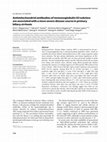
Liver International, Oct 3, 2007
Background/Aims: Primary biliary cirrhosis (PBC) is characterised by the presence of immunoglobul... more Background/Aims: Primary biliary cirrhosis (PBC) is characterised by the presence of immunoglobulin (Ig) G antimitochondrial antibodies (AMA), which are routinely detected by indirect immunofluorescence (IFL) using composite rodent tissue substrate. The IgG subclass distribution and clinical significance of IFLdetected AMA in patients with PBC have not been previously studied in detail. Methods: We have examined IgG subclass-specific AMA detected by IFL on rodent liver, kidney and stomach tissue substrate using affinity-purified IgG subclass monospecific antisera as revealing reagents in 95 AMA-positive PBC patients from Greece. Results: AMA of any of the IgG1, IgG2 or IgG3 subclasses were present in 89/95 (93.7%) patients. Among those 89, 55 (61.8%) had IgG1, 2, 3 AMA positivity; eight (9%) had IgG1, 2; seven (7.9%) had IgG2, 3; eight (9%) had IgG1, 3; nine (10.1%) had IgG1 subclass and two (2.2%) single IgG3 AMA reactivity. IgG4 AMA was absent. IgG3 titres were higher than IgG2 and IgG1 (P o 0.001) and IgG1 higher than IgG2 (P o 0.001). IgG3 AMA-positive patients had a histologically more advanced disease (P o 0.01) and were more frequently cirrhotic compared with those who were negative (P o 0.01). There was a positive correlation between AMA IgG3 titre and Mayo risk score (r = 0.55, P = 0.009, Spearman's correlation). Conclusions: Our findings suggest that AMA are not restricted to a specific IgG subclass. AMA of the IgG3 subclass are associated with a more severe disease course, possibly reflecting the peculiar ability of this isotype to engage mediators of damage.
Critical Reviews in Food Science and Nutrition, Jul 28, 2022
Gkiouras et al. Efficacy of n-3 fatty acid supplementation on rheumatoid arthritis' disease activ... more Gkiouras et al. Efficacy of n-3 fatty acid supplementation on rheumatoid arthritis' disease activity indicators: a systematic review and metaanalysis of randomized placebo-controlled trials Supplementary material
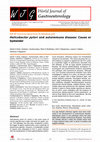
World Journal of Gastroenterology, 2014
Helicobacter pylori (H. pylori) is the main cause of chronic gastritis and a major risk factor fo... more Helicobacter pylori (H. pylori) is the main cause of chronic gastritis and a major risk factor for gastric cancer. This pathogen has also been considered a potential trigger of gastric autoimmunity, and in particular of autoimmune gastritis. However, a considerable number of reports have attempted to link H. pylori infection with the development of extra-gastrointestinal autoim-mune disorders, affecting organs not immediately relevant to the stomach. This review discusses the current evidence in support or against the role of H. pylori as a potential trigger of autoimmune rheumatic and skin diseases, as well as organ specific autoimmune diseases. We discuss epidemiological, serological, immunological and experimental evidence associating this pathogen with autoimmune diseases. Although over one hundred autoimmune diseases have been investigated in relation to H. pylori , we discuss a select number of papers with a larger literature base, and include Sjögrens syndrome, rheumatoid arthritis, systemic lupus erythematosus, vasculitides, autoimmune skin conditions, idiopathic thrombocytopenic purpura, autoimmune thyroid disease, multiple sclerosis, neuromyelitis optica and autoimmune liver diseases. Specific mention is given to those studies reporting an association of anti-H. pylori antibodies with the presence of autoimmune disease-specific clinical parameters, as well as those failing to find such associations. We also provide helpful hints for future research.
Clinica Chimica Acta, Nov 1, 2006
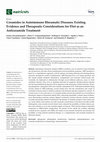
Nutrients
Autoimmune rheumatic diseases (AIRDs) constitute a set of connective tissue disorders and dysfunc... more Autoimmune rheumatic diseases (AIRDs) constitute a set of connective tissue disorders and dysfunctions with akin clinical manifestations and autoantibody responses. AIRD treatment is based on a comprehensive approach, with the primary aim being achieving and attaining disease remission, through the control of inflammation. AIRD therapies have a low target specificity, and this usually propels metabolic disturbances, dyslipidemias and increased cardiovascular risk. Ceramides are implicated in inflammation through several different pathways, many of which sometimes intersect. They serve as signaling molecules for apoptosis, altering immune response and driving endothelial dysfunction and as regulators in the production of other molecules, including sphingosine 1-phosphate (S1P) and ceramide 1-phosphate (C1P). With lipid metabolism being severely altered in AIRD pathology, several studies show that the concentration and variety of ceramides in human tissues is altered in patients with ...
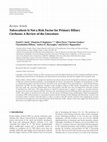
Tuberculosis research and treatment, 2012
Primary biliary cirrhosis (PBC) is a progressive cholestatic liver disease characterised serologi... more Primary biliary cirrhosis (PBC) is a progressive cholestatic liver disease characterised serologically by cholestasis and the presence of high-titre antimitochondrial antibodies, and histologically by chronic nonsuppurative cholangitis and granulomata. As PBC is a granulomatous disease and Mycobacterium tuberculosis is the most frequent cause of granulomata, a causal relation between tuberculosis and PBC has been suggested. Attempts to find serological evidence of PBC-specific autoantibodies such as AMA have been made and, conversely, granulomatous livers from patients with PBC have been investigated for molecular evidence of Mycobacterium tuberculosis. This paper discusses in detail the reported data in support or against an association between Mycobacterium tuberculosis infection and PBC. We discuss the immunological and microbiological data exploring the association of PBC with exposure to Mycobacterium tuberculosis. We also discuss the findings of large epidemiologic studies inv...
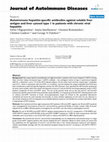
Journal of autoimmune diseases, Jan 4, 2007
Non-organ specific autoantibodies are highly prevalent in patients with chronic hepatitis C (HCV)... more Non-organ specific autoantibodies are highly prevalent in patients with chronic hepatitis C (HCV). Among them, anti-liver kidney microsomal type 1 (LKM1) antibody--the serological marker of type 2 autoimmune hepatitis (AIH-2)--is detected in up to 11% of the HCV-infected subjects. On the other hand, anti-liver cytosol type 1 antibodies (anti-LC1)--either in association with anti-LKM1, or in isolation--and anti-soluble liver antigen antibodies (anti-SLA) have been considered as useful and specific diagnostic markers for AIH. However, their specificity for AIH has been questioned by some recent studies, which have shown the detection of anti-LC1 and anti-SLA by immunoprecipitation assays in HCV patients irrespective of their anti-LKM1 status. The aim of the present study was to test the anti-LC1 and anti-SLA presence by specific enzyme linked immunosorbent assays (ELISAs), in a large group of Greek HCV-infected patients with or without anti-LKM1 reactivity as firstly, immunoprecipitat...
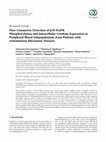
Journal of Immunology Research, 2014
Flow cytometric analysis of p38 mitogen-activated protein kinase (p38 MAPK) signaling cascade is ... more Flow cytometric analysis of p38 mitogen-activated protein kinase (p38 MAPK) signaling cascade is optimally achieved by methanol permeabilization protocols. Such protocols suffer from the difficulties to accurately detect intracellular cytokines and surface epitopes of infrequent cell subpopulations, which are removed by methanol. To overcome these limitations, we have modified methanol-based phosphoflow protocols using several commercially available antibody clones suitable for surface antigens, intracellular cytokines, and p38 MAPK. These included markers of B cells (CD19, CD20, and CD22), T cells (CD3, CD4, and CD8), NK (CD56 and CD7), and dendritic cells (CD11c). We have also tested surface markers of costimulatory molecules, such as CD27. We have successfully determined simultaneous expression of IFN-γ, as well as IL-10, and phosphorylated p38 in cell subsets. The optimized phosphoflow protocol has also been successfully applied in peripheral blood mononuclear cells or purified ...
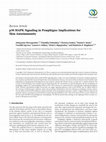
Autoimmune Diseases, 2013
p38 mitogen activated protein kinase (p38 MAPK) signaling plays a major role in the modulation of... more p38 mitogen activated protein kinase (p38 MAPK) signaling plays a major role in the modulation of immune-mediated inflammatory responses and therefore has been linked with several autoimmune diseases. The extent of the involvement of p38 MAPK in the pathogenesis of autoimmune blistering diseases has started to emerge, but whether it pays a critical role is a matter of debate. The activity of p38 MAPK has been studied in great detail during the loss of keratinocyte cell-cell adhesions and the development of pemphigus vulgaris (PV) and pemphigus foliaceus (PF). These diseases are characterised by autoantibodies targeting desmogleins (Dsg). Whether autoantibody-antigen interactions can trigger signaling pathways (such as p38 MAPK) that are tightly linked to the secretion of inflammatory mediators which may perpetuate inflammation and tissue damage in pemphigus remains unclear. Yet, the ability of p38 MAPK inhibitors to block activation of the proapoptotic proteinase caspase-3 suggests ...
Journal of Hepatology, 2010
Journal of Hepatology, 2006
Conclusion: Monocyte-associated B7-H1 suppressed the ability of HCVspecific CD4+ Thl cells and CD... more Conclusion: Monocyte-associated B7-H1 suppressed the ability of HCVspecific CD4+ Thl cells and CD8+ CTLs to generate a functional effector T cell response.
Journal of Hepatology, 2006
Conclusion: Monocyte-associated B7-H1 suppressed the ability of HCVspecific CD4+ Thl cells and CD... more Conclusion: Monocyte-associated B7-H1 suppressed the ability of HCVspecific CD4+ Thl cells and CD8+ CTLs to generate a functional effector T cell response.

Uploads
Papers by Eirini Rigopoulou